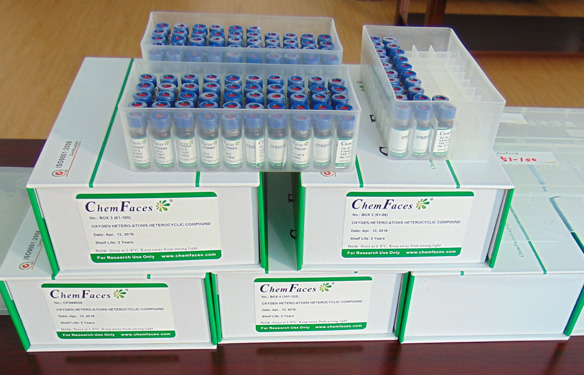Dihydrodehydrodiconiferyl alcohol
Dihydrodehydrodiconiferyl alcohol exhibits in vitro cytotoxicity in various cancer cell lines. It may be useful candidates for developing therapeutic agents for the prevention and treatment of hepatic fibrosis.
Inquire / Order:
manager@chemfaces.com
Technical Inquiries:
service@chemfaces.com
Tel:
+86-27-84237783
Fax:
+86-27-84254680
Address:
1 Building, No. 83, CheCheng Rd., Wuhan Economic and Technological Development Zone, Wuhan, Hubei 430056, PRC
Providing storage is as stated on the product vial and the vial is kept tightly sealed, the product can be stored for up to
24 months(2-8C).
Wherever possible, you should prepare and use solutions on the same day. However, if you need to make up stock solutions in advance, we recommend that you store the solution as aliquots in tightly sealed vials at -20C. Generally, these will be useable for up to two weeks. Before use, and prior to opening the vial we recommend that you allow your product to equilibrate to room temperature for at least 1 hour.
Need more advice on solubility, usage and handling? Please email to: service@chemfaces.com
The packaging of the product may have turned upside down during transportation, resulting in the natural compounds adhering to the neck or cap of the vial. take the vial out of its packaging and gently shake to let the compounds fall to the bottom of the vial. for liquid products, centrifuge at 200-500 RPM to gather the liquid at the bottom of the vial. try to avoid loss or contamination during handling.
Pharmacia2024, 71:1-9.
Nutrients.2020, 12(5):1242.
Int J Mol Sci.2023, 24(14):11496.
Journal of Food Composition and Analysis2021, 100:103905.
Oxid Med Cell Longev.2020, 2020:8887251.
Drug Des Devel Ther.2023, 17:2461-2479.
Clin Exp Pharmacol Physiol.2020, doi: 10.1111
Progress In Microbes & Molecular Biology2025, 8,1:a0000470.
Plants (Basel).2024, 13(23):3314.
Nat Prod Commun.2017, 12(5):771-778
Related and Featured Products
Biol Pharm Bull. 2015;38(2):228-34.
Antifibrotic compounds from Liriodendron tulipifera attenuating HSC-T6 proliferation and TNF-α production in RAW264.7 cells.[Pubmed:
25747981]
The inhibition of hepatic stellate cell (HSC) proliferation has been considered as an effective therapeutic target for the treatment of liver fibrosis.
METHODS AND RESULTS:
The methanolic extract of Liriodendron tulipifera showed significant inhibitory activity against the proliferation of HSCs. Bioactivity-guided isolation afforded twelve compounds including (-)-sesamin (1), (-)-syringaresinol (2), (+)-Dihydrodehydrodiconiferyl alcohol (3), salvinal (4), (+)-guaiacylglycerol-8-O-4'-dihydroconiferyl ether (5), (±)-guaiacylglycerol-8-O-4'-sinapyl alcohol ether (6), tanegool (7), (+)-5,5'-dimethoxy-7-oxolariciresinol (8), 3-hydroxy-4-methoxyacetophenone (9), 4-acetoxymethylphenol (10), (-)-paramicholide (11), and blumenol A (12). Among the compounds isolated, 2, 3 and 4 significantly attenuated the proliferation of the activated HSC-T6 cells. The maximal dose of these compounds, however, showed no cytotoxicity in primary cultured rat hepatocytes. Collagen deposition in the activated HSC-T6 cells was reduced by 2, 3 and 4. Also, the increased production of the pro-inflammatory cytokine tumor necrosis factor (TNF)-α induced by lipopolysaccharide was decreased by 3 and 4 in RAW264.7 macrophage cells. Collectively, (-)-syringaresinol (2), (+)-Dihydrodehydrodiconiferyl alcohol (3), and salvinal (4) isolated from L. tulipifera leaves and twigs exhibited selective antifibrotic activities toward the activated HSCs and suppressed TNF-α production in RAW264.7 macrophages.
CONCLUSIONS:
These compounds may be useful candidates for developing therapeutic agents for the prevention and treatment of hepatic fibrosis.
at. Prod. Lett., 1994, 4(4):267-72.
Revision of the NMR Assignments of Pterostilbene and of Dihydrodehydrodiconieferyl alcohol: Cytotoxic Constituents from Anogeissus acuminata.[Reference:
WebLink]
Further phytochemical work on Anogeissus acuminata var. lanceolata (Combretaceae) led to the isolation of pterostilbene (1), Dihydrodehydrodiconiferyl alcohol (2), and conocarpan (3).
METHODS AND RESULTS:
The structure of these compounds were determined by spectroscopic means, mainly through 1D and 2D NMR experiments. A revision of some of the 13C NMR chemical shifts of 1 and 2 were made possible by HETCOR, FLOCK, and selective INEPT experiments. Homonuclear spin-decoupling and 1H-1H COSY experiments also enabled the precise assignment of the 1H NMR chemical shifts of 2.
CONCLUSIONS:
Compounds 1–3 exhibited in vitro cytotoxicity in various cancer cell lines. This is the first isolation of 1–3 from Anogeissus.


